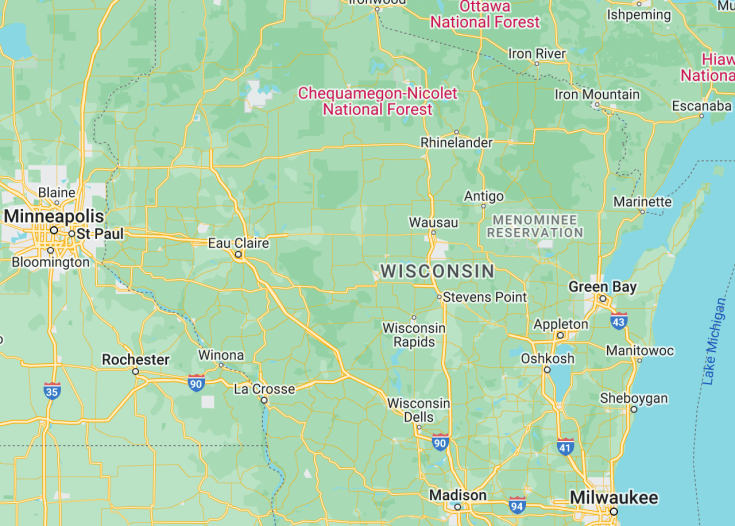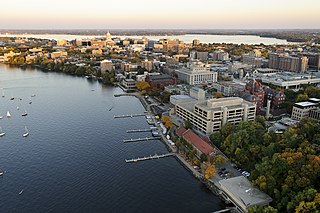Wisconsin, the “Badger State” nestled in America’s Midwest, is a haven of diverse landscapes and rich culture. From the vibrant urban life of Milwaukee and Madison to the tranquil beauty of the Apostle Islands on Lake Superior, Wisconsin promises both adventure and relaxation. It’s a state where dairy farms meet bustling cities, and where the traditions of its indigenous peoples, like the Ojibwe and Ho-Chunk, intertwine with modern attractions. Whether you’re indulging in artisanal cheeses, exploring pristine lakes, or immersing yourself in the arts, Wisconsin’s unique charm beckons.
Visit in autumn to witness the state’s breathtaking fall foliage and partake in seasonal festivals.
Allocate time to explore both the urban centers and the scenic Door County peninsula for a comprehensive experience.
Top destinations in Wisconsin (USA)
Wisconsin: America’s dairyland beckons
| Capital | Madison |
| Time in Wisconsin | Central Standard Time (CST), GMT-6 |
| Language spoken | English |
| Population | Approximately 5.8 million (U.S. Census Bureau, 2020) |
| Religion | Christianity (71%) Unaffiliated (25%) Others (4%) |
| Currency | US Dollar($, USD) |
| Airports | Dane County Regional Airport General Mitchell International Airport Austin Straubel International Airport |
Nestled in the northern-central part of the United States, Wisconsin offers an intricate blend of natural beauty, industrial prowess, and cultural richness. Often dubbed the “Badger State” or “America’s Dairyland,” it boasts a legacy intertwined with both nature’s splendor and human ingenuity.
The state’s historical narrative is punctuated by its indigenous tribes, European settlers, and its rise as an agricultural and industrial hub. Wisconsinites take immense pride in their dairy legacy, particularly the world-renowned cheeses that emerge from its pastures. Beyond agriculture, Wisconsin played a role in the lumber and brewing industries, leaving an indelible mark on America’s economic fabric.
Visitors are often drawn to its varied landscapes. From the majestic Great Lakes shores, particularly Lake Superior and Lake Michigan, to the verdant Northwoods, there’s a perennial allure to its terrains. State parks, forests, and scenic trails, such as the Ice Age National Scenic Trail, beckon nature enthusiasts and provide a haven for numerous recreational activities year-round.
Equally captivating are the state’s urban centers like Milwaukee, known for its brewing legacy and vibrant arts scene, and Madison, the state capital, brimming with historic landmarks and a youthful vibe courtesy of the University of Wisconsin. Cultural festivals, musical events, and local gastronomy, featuring dairy delights and farm-to-table offerings, provide glimpses of Wisconsin’s multifaceted identity.
Whether one is drawn by the serenity of its landscapes, the charm of its towns, or the warmth of its residents, Wisconsin promises an enriching and diverse travel experience.
Where is Wisconsin located?
Wisconsin is located in the north-central region of the United States. It is bordered by Lake Superior to the north, Lake Michigan to the east, Illinois to the south, and Minnesota and Iowa to the west.
What is Wisconsin famous for?
Wisconsin is famed for its dairy production, especially cheese. It’s also known for its picturesque landscapes, encompassing forests, lakes, and state parks, as well as its rich industrial and cultural heritage, including brewing and arts festivals.
History
Prehistoric Era: First Inhabitants
Thousands of years before European explorers reached the shores of what is now Wisconsin, the region was inhabited by indigenous tribes. Ancient cultures such as the Mound Builders left behind burial mounds, many of which can still be seen today. Over time, tribes like the Menominee, Ojibwa (Chippewa), Potawatomi, and Ho-Chunk (Winnebago) established vibrant communities across the region.
1600s-1700s: European Exploration and Fur Trade
European contact with Wisconsin began in the 17th century, with explorers like Jean Nicolet and Jacques Marquette making some of the earliest recorded visits. These initial contacts paved the way for the flourishing fur trade, drawing French, and later British, traders and trappers to the region. Wisconsin’s rivers, especially the Wisconsin and Mississippi, became vital trade routes during this era.
1800s: Territorial Era and Statehood
By the early 19th century, American expansion brought settlers into Wisconsin. In 1836, the Wisconsin Territory was formally established. Rapid settlement, driven by mining (the so-called “Lead Rush”) and agriculture, led to increased demand for statehood. On May 29, 1848, Wisconsin was admitted to the Union as the 30th state. The capital was established in Madison, a city purposefully built for this role.
Mid-1800s to Early 1900s: Economic Growth and Industrialization
This period saw the rise of Wisconsin as a national leader in various industries, particularly dairy farming, logging, and manufacturing. The state earned its nickname, “America’s Dairyland,” due to its prodigious cheese and butter production. Meanwhile, cities like Milwaukee became hubs for brewing and manufacturing, drawing immigrants from Germany, Scandinavia, and other parts of Europe.
Early to Mid-20th Century: Wars and Social Change
Wisconsin played a significant role during both World Wars, with many of its citizens serving overseas, and its industries supporting war efforts. The state was also a focal point for the Progressive movement, led by figures like Robert La Follette, which sought to address societal issues through reform. This era also saw the growth of Wisconsin’s renowned public university system, cementing its reputation for educational excellence.
Late 20th Century to Present: Modern Challenges and Innovations
In the latter part of the 20th century, Wisconsin, like much of the industrial Midwest, faced economic challenges as manufacturing jobs declined. However, the state proved resilient, diversifying its economy and emphasizing sectors like healthcare, education, and technology. Today, Wisconsin remains a hub for innovation, with a strong emphasis on community, environmental sustainability, and preserving its rich cultural heritage.
Visit Wisconsin
What to see and do in Wisconsin
When visiting Wisconsin, there is a wide range of attractions and activities to explore. Here are some highlights:
- Explore the vibrant city of Milwaukee, known for its breweries, museums (such as the Milwaukee Art Museum), and the historic Third Ward district.
- Visit the state capital, Madison, home to the University of Wisconsin-Madison, beautiful lakes, and the impressive Wisconsin State Capitol building.
- Discover the stunning natural landscapes of Door County, famous for its picturesque waterfront towns, lighthouses, and cherry orchards.
- Experience the charm of small-town Wisconsin by visiting places like Lake Geneva, with its scenic lakefront, boutiques, and historic mansions.
- Enjoy outdoor activities in the Wisconsin Dells area, known for its water parks, scenic river tours, and rock formations.
- Immerse yourself in history by visiting sites like the Old World Wisconsin living history museum or the Apostle Islands National Lakeshore.
Events in Wisconsin
Wisconsin hosts a variety of events throughout the year, catering to different interests and passions:
- Wisconsin State Fair (August): One of the largest state fairs in the United States, featuring agricultural exhibits, live entertainment, and delicious food.
- Summerfest (June-July): An iconic music festival in Milwaukee, known as “The World’s Largest Music Festival,” featuring performances by renowned artists.
- Door County Cherry Festival (July): Celebrates the harvest of cherries in Door County with cherry-themed food, drinks, and activities.
- Brat Fest (May): A popular festival in Madison centered around bratwurst, with live music, games, and activities for the whole family.
- Great Taste of the Midwest (August): A beer festival in Madison showcasing a wide selection of craft beers from breweries across the Midwest.
Best time to visit Wisconsin
The best time to visit Wisconsin depends on personal preferences and the desired activities. The state experiences all four seasons, each offering unique opportunities:
Spring (March-May) is a great time to witness the stunning bloom of flowers, especially in places like Door County. The weather is mild, and outdoor activities start to pick up.
Summer (June-August) is the peak tourist season, with warm temperatures and a plethora of outdoor events and festivals, such as Summerfest in Milwaukee and various county fairs.
Fall (September-November) is renowned for its vibrant foliage, particularly in areas like the Kettle Moraine State Forest. It is a beautiful time to go hiking or enjoy fall harvest festivals.
Winter (December-February) offers opportunities for winter sports like skiing, snowboarding, and ice fishing. The holiday season brings festive attractions and decorations to cities like Milwaukee and Madison.
Is Wisconsin worth visiting?
Wisconsin is undoubtedly worth visiting for various reasons. The state’s natural beauty, from its stunning lakeshores to its picturesque landscapes, attracts outdoor enthusiasts seeking adventure and relaxation. The vibrant cities offer a blend of history, culture, and culinary delights, making them appealing destinations for urban explorers.
Furthermore, Wisconsin’s rich history, including its Native American heritage and contributions to the Civil War, provides ample opportunities to delve into the past. The state’s progressive and forward-thinking approaches make it an interesting place to witness and participate in social and political movements.














